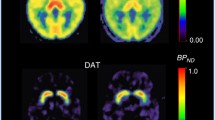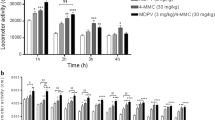Summary
The potent and selective D2-agonist N-0437 [2-(N-propyl-N-2-thienylethylamino)-5-hydroxytetralin] undergoes considerable first-pass metabolism after oral administration due to glucuronidation of the phenolic group. In an attempt to improve its bioavailability, seven ester prodrugs of N-0437 were synthesized, i. e. the acetyl-, propionyl-, isobutyryl-, pivaloyl-, 2-aminophenyl-, 2-methoxy-phenyl- and 2,4-dimethylphenylanalogues. In vivo activities were assessed by measuring contralateral turning after transdermal administration of N-0437 and its prodrugs to rats with unilateral 6-OHDA lesions of the nigrostriatal pathway. From time-effect curves the area under the curve for separate time intervals was taken as a measure of dopaminergic activity during that interval. It was found that slowly hydrolyzing prodrugs, which are known to show an improved duration of action after oral administration, are devoid of activity after transdermal application. The acetyl-, the propionyl-and the isobutyryl analogues, which are prodrugs with a relatively high hydrolysis rate, were found to have interesting and promising profiles following transdermal application.
Similar content being viewed by others
References
Barry BW (1987) Transdermal drug delivery. In: Johnson P, Lloyd-Jones HG (eds) Drug delivery systems — fundamentals and techniques. Ellis Horwood, Chichester
Bundgaard H (1984) Improved drug delivery by the prodrug approach. In: Müller BW (ed) Controlled drug delivery. Wissenschaftliche Verlagsgesellschaft, Stuttgart, pp 179–196
Bundgaard H (1985) Design of prodrugs: bioreversible derivatives for various functional groups and chemical entities. In: Bundgaard H (ed) Design of prodrugs. Elsevier, Amsterdam, pp 1–92
Chan SY, Li Wan Po A (1989) Prodrugs for dermal delivery. Int J Pharm 55:1–16
Coleman RJ, Lange KW, Quinn NP, Loper AE, Bondi JV, Hichens M, Stahl SM, Marsden CD (1989) The antiparkinsonian actions and pharmacokinetics of transdermal (±)-4-propyl-9-hydroxynaphthoxazine (+PHNO): preliminary results. Movement Disorders 4:129–138
Den Daas I, Tepper PG, Horn AS (1990) Improvement of the oral bioavailability of the selective dopamine agonist N-4037 in rats: the in vitro and in vivo activity of eight ester prodrugs. Naunyn-Schmiedeberg's Arch Pharmacol 341:186–191
Gerding TK, Drenth BFH, De Zeeuw RA, Tepper PG, Horn AS (1990) The metabolic fate of the dopamine agonist 2-(N-propylN-2-hienylethylamino)-5-hydroxytetralin (N-0437) in rats after intravenous and oral administration. II Isolation and identification of metabolites. Xenobiotica 20:525–536
Hadgraft J (1985) Prodrugs and skin absorption. In: Bundgaard H (ed) Design of prodrugs. Elsevier, Amsterdam, pp 271–289
Higuchi WI, Yu C-D (1983) Prodrugs in transdermal delivery. In: Kydonieus AF, Berner B (eds) Transdermal delivery of drugs. vol 3. CRC Press, Boca Raton, pp 44–83
König JFR, Klippel RA (1963) The rat brain: a stereotaxic atlas of the forebrain and lower parts of the brainstem. Williams and Wilkins, Baltimore
Löschmann P-A, Chong PN, Nomoto M, Tepper PG, Horn AS, Jenner P, Marsden CD (1989) Stereoselective reversal of MPTP-induced parkinsonism in the marmoset after dermal application of N-0437. Eur J Pharmacol 166:373–380
Martin YC (1978) Calculation of the physical properties of compounds. In: Quantitative drug design, a critical introduction. Dekker, New York, pp 61–95
Monkhouse DC, Juq AS (1988) Transdermal drug delivery — problems and promises. Drug Dev Ind Pharm 14:183–209
Mouradian MM, Juncos JC, Fabbrini G, Chase TN (1987) Motor fluctuations in Parkinson's disease: pathogenetic and therapeutic studies. Ann Neurol 22:475–479
Pflegel P, Dittgen M (1987) Arzneimittel and Organismus (VI) —transdermale therapeutische Systeme. Pharmazie 42:799–809
Rinne UK (1989) Early dopamine agonist therapy in Parkinson's disease. Movement Disorders 4:S86-S94
Rupniak NMJ, Tye SJ, Jennings CA, Loper AE, Bondi JV, Hichens M, Hand E, Iversen SD, Stahl SM (1989) Antiparkinsonian efficacy of a novel transdermal delivery system for (+)-PHNO in MPTP-treated squirrel monkeys. Neurology 39:329–335
Sloan KB (1989) Prodrugs for dermal delivery. Adv Drug Delivery Rev 3:67–101
Timmerman W, Westerink BHC, De Vries JB, Tepper PG, Horn AS (1989) Microdialysis and striatal dopamine release: stereoselective actions of the enantiomers of N-0437. Eur J Pharmacol 162:143–150
Ungerstedt U, Arbuthnott AW (1970) Quantitative recording of rotational behavior in rats after 6-hydroxy-dopamine lesions of the nigrostriatal dopamine system. Brain Res 24:485–493
Van der Weide J, De Vries JB, Tepper PG, Horn AS (1987) In vitro binding of the very potent and selective D-2 dopamine agonist [3H]N-0437 to calf caudate membranes. Eur J Pharmacol 134:211–219
Wooten GF (1988) Progress in understanding the pathophysiology of treatment-related fluctuations in Parkinson's disease. Ann Neur 24:363–365
Author information
Authors and Affiliations
Additional information
Deceased January 2, 1990
Send offprint requests to I. den Daas at the above address
Rights and permissions
About this article
Cite this article
den Daas, I., Tepper, P.G., Rollema, H. et al. Transdermal administration of the dopamine agonist N-0437 and seven ester prodrugs: comparison with oral administration in the 6-OHDA turning model. Naunyn-Schmiedeberg's Arch Pharmacol 342, 655–659 (1990). https://doi.org/10.1007/BF00175708
Received:
Accepted:
Issue Date:
DOI: https://doi.org/10.1007/BF00175708




